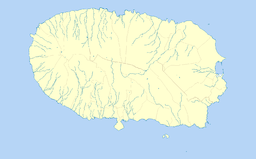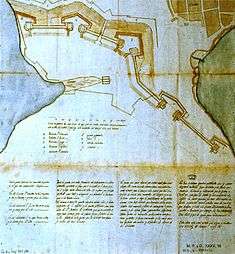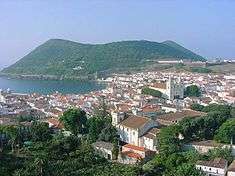Redoubt of Três Paus
| Redoubt of Três Paus (Reduto dos Três Paus) | |
| Redoubt of Three Sticks/Clubs, Fort of Benedict the Moor | |
| Fort (Forto) | |
| The remains of the small buildings associated with the fort of São Benedito on the western edge of Monte Brasil | |
| Official name: Reduto dos Três Paus/Forte de São Benedito de Monte Brasil | |
| Name origin: three sticks/clubs | |
| Country | |
|---|---|
| Autonomous region | |
| Group | Central |
| Island | Terceira |
| Municipality | Angra do Heroísmo |
| Location | Sé |
| Architects | Tommaso Benedetto |
| Styles | Medieval, Fortification |
| Materials | Basalt, Tuff |
| Origin | 1543 |
| - Initiated | 15th-16th century |
| For public | Private |
| Management | Portuguese Army |
| Operator | Portuguese Army |
 Location of the fortification within the municipality of Angra do Heroísmo, island of Terceira
| |
The Redoubt of Três Paus (Portuguese: Reduto dos Três Paus) is a fortification situated on the peninsula of Monte Brasil, in the civil parish of Sé, in the municipality of Angra do Heroísmo, in the Porutguese archipelago of the Azores. Part of the fortified defenses of the Fortress of São João Baptista, it was also known as the Fort/Redoubt of Benedict the Moor (Portuguese: Forte/Reduto de São Benedito do Monte Brasil).
History

Bartolomeu Ferraz first presented his recommendations to John III of Portugal in 1543 for the fortification of the Azores, then an important waypoint in trans-Atlantic commerce between the Indies and America.[1] On 5 March 1567, in his proposal to the Crown, Engineer Tommaso Benedetto elaborated a plan to protect the island's coastal defence, that included the construction of a fort on Monte Brasil.[1] Shortly following this proposal, the Portuguese Crown began the construction of the Fort of Dois Paus, in order to protect the port of Dois Paus-Portinho Novo.[1]
During the dynastic crisis (in 1580), the Azores supported the Portuguese cause of António, Prior of Crato and his claim to the throne, resulting in an insular rebellion that lasted for three years.[1] The anti-Philippine resistance was determined to reinforce the coastal fortifications.[1] On 13 October 1581, a letter from Frair Simão de Barros was sent to Queen Elizabeth for military assistance.[1] In order to prepare the resistance on the island, fortifications were constructed on the eastern coast of Monte Brasil: the Fort of Santo António and Fort of São Benedito, that included a long wall and trench, and to the west the establishment of the Fort of Zimbreiro.[1]
In the context of the installation of the Captaincy-General of the Azores, the status of the fortifications were reported as:
- ...In the stated redoubt of Benedict the Moor, it has eight canon emplacements and four peices of iron, three esfuguenadas, and requires another four with its equipment.[2]
The redoubt was part of an array of coastal defences on the eastern coast of Monte Brasil, oriented toward the Bay of Angra, that included the Redoubt of Dois Paus, Redoubt of São Francisco, the Redoubt of Santo Inácio and the Fort of Santo António.[1] It currently includes several abandoned and derelict buildings, and is found in a state of ruin.
References
Notes
Sources
- Júdice, João António (1981), "Revistas feitas no Castello de S. João Baptista, Forte de S. Sebastião e de todos os mais fortes que tem esta Ilha Terceira", Arquivo dos Açores, V (facsimile 1883), Ponta Delgada (Azores): Universidade dos Açores, Arquivo Nacional da Torre do Tombo (Papéis do Ministério do Reino, Maço 611), pp. 407–418
- Mota, Valdemar (1994), "Fortificação da Ilha Terceira", Boletim do Instituto Histórico da Ilha Terceira, (in Portuguese), LI-LII
- Vieira, Alberto (1987), "Da poliorcética à fortificação nos Açores: introdução ao estudo do sistema defensivo nos Açores nos séculos XVI-XIX", Boletim do Instituto Histórico da Ilha Terceira (in Portuguese), XLV, Tomo II
